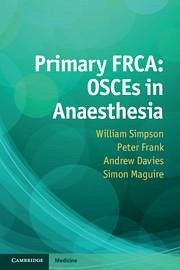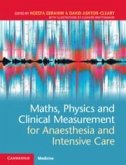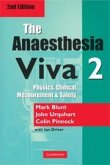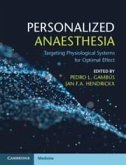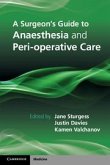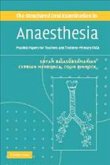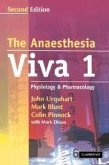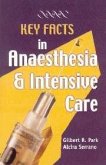- Broschiertes Buch
- Merkliste
- Auf die Merkliste
- Bewerten Bewerten
- Teilen
- Produkt teilen
- Produkterinnerung
- Produkterinnerung
An up-to-date revision guide specifically for the primary FRCA OSCE exam.
Andere Kunden interessierten sich auch für
![Maths, Physics and Clinical Measurement for Anaesthesia and Intensive Care Maths, Physics and Clinical Measurement for Anaesthesia and Intensive Care]() Maths, Physics and Clinical Measurement for Anaesthesia and Intensive Care77,99 €
Maths, Physics and Clinical Measurement for Anaesthesia and Intensive Care77,99 €![The Anaesthesia Viva: Volume 2 The Anaesthesia Viva: Volume 2]() Mark BluntThe Anaesthesia Viva: Volume 2129,99 €
Mark BluntThe Anaesthesia Viva: Volume 2129,99 €![Personalized Anaesthesia Personalized Anaesthesia]() Personalized Anaesthesia133,99 €
Personalized Anaesthesia133,99 €![A Surgeon's Guide to Anaesthesia and Peri-Operative Care A Surgeon's Guide to Anaesthesia and Peri-Operative Care]() A Surgeon's Guide to Anaesthesia and Peri-Operative Care72,99 €
A Surgeon's Guide to Anaesthesia and Peri-Operative Care72,99 €![The Structured Oral Examination in Anaesthesia The Structured Oral Examination in Anaesthesia]() Shyam BalasubramanianThe Structured Oral Examination in Anaesthesia141,99 €
Shyam BalasubramanianThe Structured Oral Examination in Anaesthesia141,99 €![The Anaesthesia Viva, Volume 1 The Anaesthesia Viva, Volume 1]() John UrquhartThe Anaesthesia Viva, Volume 1109,99 €
John UrquhartThe Anaesthesia Viva, Volume 1109,99 €![Key Facts in Anaesthesia and Intensive Care Key Facts in Anaesthesia and Intensive Care]() Gilbert R ParkKey Facts in Anaesthesia and Intensive Care42,99 €
Gilbert R ParkKey Facts in Anaesthesia and Intensive Care42,99 €-
-
-
An up-to-date revision guide specifically for the primary FRCA OSCE exam.
Hinweis: Dieser Artikel kann nur an eine deutsche Lieferadresse ausgeliefert werden.
Hinweis: Dieser Artikel kann nur an eine deutsche Lieferadresse ausgeliefert werden.
Produktdetails
- Produktdetails
- Verlag: Cambridge University Press
- Seitenzahl: 304
- Erscheinungstermin: 16. September 2013
- Englisch
- Abmessung: 229mm x 155mm x 8mm
- Gewicht: 567g
- ISBN-13: 9781107652231
- ISBN-10: 1107652235
- Artikelnr.: 36956087
- Herstellerkennzeichnung
- Libri GmbH
- Europaallee 1
- 36244 Bad Hersfeld
- gpsr@libri.de
- Verlag: Cambridge University Press
- Seitenzahl: 304
- Erscheinungstermin: 16. September 2013
- Englisch
- Abmessung: 229mm x 155mm x 8mm
- Gewicht: 567g
- ISBN-13: 9781107652231
- ISBN-10: 1107652235
- Artikelnr.: 36956087
- Herstellerkennzeichnung
- Libri GmbH
- Europaallee 1
- 36244 Bad Hersfeld
- gpsr@libri.de
William Simpson is a Trainee Anaesthetist at North Western Deanery, Manchester, UK.
Table of contents
Preface
Acknowledgements
Part I. Anatomy: 1. Trachea
2. Brachial Plexus
3. Great veins of the neck
4. Antecubital fossa
5. Ankle block
6. Circle of Willis
7. Coronary circulation
8. Base of skull
9. Diaphragm
10. Spinal cord
11. Wrist
12. Larynx
Answers
Part II. History Taking: Introduction
1. TURP surgery
2. Laparoscopic cholecystectomy
3. Thyroid surgery
4. Shoulder replacement
5. Caesarean section
6. ENT surgery
Answers
Part III. Communication: Introduction
1. Sickle cell test
2. Rapid sequence induction
3. Suxamethonium apnoea
4. Cancelled surgery
5. Tooth damage
6. Jehovah's witness
Part IV. Equipment: 1. Diathermy
2. Defibrillators
3. Laryngoscopes
4. Endotracheal tubes
5. Breathing circuits
6. Airways
7. Vaporisers
8. Scavenging
9. Medical gases
10. Filters
11. Ventilators
Answers
Part V. Anaesthetic Hazards: 1. Electricity
2. Lasers
3. Positioning
4. Blood transfusion
Answers
Part VI. Radiology: 1. Chest x-ray 1
2. Chest x-ray 2
3. CT head
4. Cervical spine
5. Angiogram
Answers
Part VII. Physical Examination: 1. Cardiovascular examination
2. Respiratory examination
3. Cranial nerve examination
4. Obstetric pre-operative assessment
5. Peripheral circulation examination
6. Airway examination
Answers
Part VIII. Resuscitation and Simulation: 1. Bradyarrhythmia
2. Collapsed obstetric patient
3. Malignant hyperthermia
4. Failed intubation
5. Displaced tracheostomy
6. Paediatric emergency
7. Intraoperative desaturation
8. Tachyarrhythmia
9. Anaphylaxis
10. Obstetric haemorrhage
Answers
Part IX. Procedures: 1. Lumbar puncture
2. Chest drain
3. Epidural
4. Surgical airway
5. Central venous cannulation
6. Intraosseous access
7. Anaesthesia of the eye
8. Rapid sequence induction
Answers
Part X. Monitoring and Measurement: 1. Capnography
2. CVP trace
3. ECG 1
4. ECG 2
5. Humidity
6. Invasive blood pressure
7. Respiratory 1
8. Respiratory 2
9. Non-invasive blood pressure
10. Oxygen measurement 1
11. Oxygen measurement 2
12. Pulmonary artery catheter
13. Nerve stimulators
14. Pulse oximetry
15. Rotameters
16. Temperature
Answers
References
Index.
Preface
Acknowledgements
Part I. Anatomy: 1. Trachea
2. Brachial Plexus
3. Great veins of the neck
4. Antecubital fossa
5. Ankle block
6. Circle of Willis
7. Coronary circulation
8. Base of skull
9. Diaphragm
10. Spinal cord
11. Wrist
12. Larynx
Answers
Part II. History Taking: Introduction
1. TURP surgery
2. Laparoscopic cholecystectomy
3. Thyroid surgery
4. Shoulder replacement
5. Caesarean section
6. ENT surgery
Answers
Part III. Communication: Introduction
1. Sickle cell test
2. Rapid sequence induction
3. Suxamethonium apnoea
4. Cancelled surgery
5. Tooth damage
6. Jehovah's witness
Part IV. Equipment: 1. Diathermy
2. Defibrillators
3. Laryngoscopes
4. Endotracheal tubes
5. Breathing circuits
6. Airways
7. Vaporisers
8. Scavenging
9. Medical gases
10. Filters
11. Ventilators
Answers
Part V. Anaesthetic Hazards: 1. Electricity
2. Lasers
3. Positioning
4. Blood transfusion
Answers
Part VI. Radiology: 1. Chest x-ray 1
2. Chest x-ray 2
3. CT head
4. Cervical spine
5. Angiogram
Answers
Part VII. Physical Examination: 1. Cardiovascular examination
2. Respiratory examination
3. Cranial nerve examination
4. Obstetric pre-operative assessment
5. Peripheral circulation examination
6. Airway examination
Answers
Part VIII. Resuscitation and Simulation: 1. Bradyarrhythmia
2. Collapsed obstetric patient
3. Malignant hyperthermia
4. Failed intubation
5. Displaced tracheostomy
6. Paediatric emergency
7. Intraoperative desaturation
8. Tachyarrhythmia
9. Anaphylaxis
10. Obstetric haemorrhage
Answers
Part IX. Procedures: 1. Lumbar puncture
2. Chest drain
3. Epidural
4. Surgical airway
5. Central venous cannulation
6. Intraosseous access
7. Anaesthesia of the eye
8. Rapid sequence induction
Answers
Part X. Monitoring and Measurement: 1. Capnography
2. CVP trace
3. ECG 1
4. ECG 2
5. Humidity
6. Invasive blood pressure
7. Respiratory 1
8. Respiratory 2
9. Non-invasive blood pressure
10. Oxygen measurement 1
11. Oxygen measurement 2
12. Pulmonary artery catheter
13. Nerve stimulators
14. Pulse oximetry
15. Rotameters
16. Temperature
Answers
References
Index.
Table of contents
Preface
Acknowledgements
Part I. Anatomy: 1. Trachea
2. Brachial Plexus
3. Great veins of the neck
4. Antecubital fossa
5. Ankle block
6. Circle of Willis
7. Coronary circulation
8. Base of skull
9. Diaphragm
10. Spinal cord
11. Wrist
12. Larynx
Answers
Part II. History Taking: Introduction
1. TURP surgery
2. Laparoscopic cholecystectomy
3. Thyroid surgery
4. Shoulder replacement
5. Caesarean section
6. ENT surgery
Answers
Part III. Communication: Introduction
1. Sickle cell test
2. Rapid sequence induction
3. Suxamethonium apnoea
4. Cancelled surgery
5. Tooth damage
6. Jehovah's witness
Part IV. Equipment: 1. Diathermy
2. Defibrillators
3. Laryngoscopes
4. Endotracheal tubes
5. Breathing circuits
6. Airways
7. Vaporisers
8. Scavenging
9. Medical gases
10. Filters
11. Ventilators
Answers
Part V. Anaesthetic Hazards: 1. Electricity
2. Lasers
3. Positioning
4. Blood transfusion
Answers
Part VI. Radiology: 1. Chest x-ray 1
2. Chest x-ray 2
3. CT head
4. Cervical spine
5. Angiogram
Answers
Part VII. Physical Examination: 1. Cardiovascular examination
2. Respiratory examination
3. Cranial nerve examination
4. Obstetric pre-operative assessment
5. Peripheral circulation examination
6. Airway examination
Answers
Part VIII. Resuscitation and Simulation: 1. Bradyarrhythmia
2. Collapsed obstetric patient
3. Malignant hyperthermia
4. Failed intubation
5. Displaced tracheostomy
6. Paediatric emergency
7. Intraoperative desaturation
8. Tachyarrhythmia
9. Anaphylaxis
10. Obstetric haemorrhage
Answers
Part IX. Procedures: 1. Lumbar puncture
2. Chest drain
3. Epidural
4. Surgical airway
5. Central venous cannulation
6. Intraosseous access
7. Anaesthesia of the eye
8. Rapid sequence induction
Answers
Part X. Monitoring and Measurement: 1. Capnography
2. CVP trace
3. ECG 1
4. ECG 2
5. Humidity
6. Invasive blood pressure
7. Respiratory 1
8. Respiratory 2
9. Non-invasive blood pressure
10. Oxygen measurement 1
11. Oxygen measurement 2
12. Pulmonary artery catheter
13. Nerve stimulators
14. Pulse oximetry
15. Rotameters
16. Temperature
Answers
References
Index.
Preface
Acknowledgements
Part I. Anatomy: 1. Trachea
2. Brachial Plexus
3. Great veins of the neck
4. Antecubital fossa
5. Ankle block
6. Circle of Willis
7. Coronary circulation
8. Base of skull
9. Diaphragm
10. Spinal cord
11. Wrist
12. Larynx
Answers
Part II. History Taking: Introduction
1. TURP surgery
2. Laparoscopic cholecystectomy
3. Thyroid surgery
4. Shoulder replacement
5. Caesarean section
6. ENT surgery
Answers
Part III. Communication: Introduction
1. Sickle cell test
2. Rapid sequence induction
3. Suxamethonium apnoea
4. Cancelled surgery
5. Tooth damage
6. Jehovah's witness
Part IV. Equipment: 1. Diathermy
2. Defibrillators
3. Laryngoscopes
4. Endotracheal tubes
5. Breathing circuits
6. Airways
7. Vaporisers
8. Scavenging
9. Medical gases
10. Filters
11. Ventilators
Answers
Part V. Anaesthetic Hazards: 1. Electricity
2. Lasers
3. Positioning
4. Blood transfusion
Answers
Part VI. Radiology: 1. Chest x-ray 1
2. Chest x-ray 2
3. CT head
4. Cervical spine
5. Angiogram
Answers
Part VII. Physical Examination: 1. Cardiovascular examination
2. Respiratory examination
3. Cranial nerve examination
4. Obstetric pre-operative assessment
5. Peripheral circulation examination
6. Airway examination
Answers
Part VIII. Resuscitation and Simulation: 1. Bradyarrhythmia
2. Collapsed obstetric patient
3. Malignant hyperthermia
4. Failed intubation
5. Displaced tracheostomy
6. Paediatric emergency
7. Intraoperative desaturation
8. Tachyarrhythmia
9. Anaphylaxis
10. Obstetric haemorrhage
Answers
Part IX. Procedures: 1. Lumbar puncture
2. Chest drain
3. Epidural
4. Surgical airway
5. Central venous cannulation
6. Intraosseous access
7. Anaesthesia of the eye
8. Rapid sequence induction
Answers
Part X. Monitoring and Measurement: 1. Capnography
2. CVP trace
3. ECG 1
4. ECG 2
5. Humidity
6. Invasive blood pressure
7. Respiratory 1
8. Respiratory 2
9. Non-invasive blood pressure
10. Oxygen measurement 1
11. Oxygen measurement 2
12. Pulmonary artery catheter
13. Nerve stimulators
14. Pulse oximetry
15. Rotameters
16. Temperature
Answers
References
Index.

